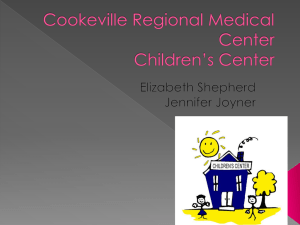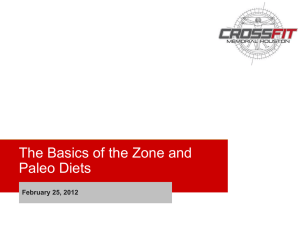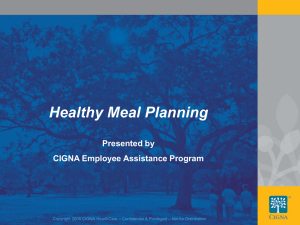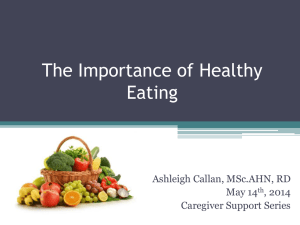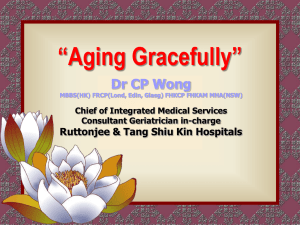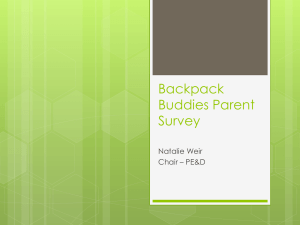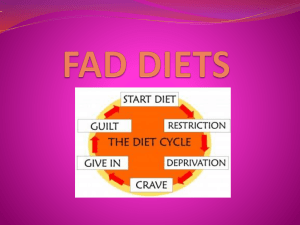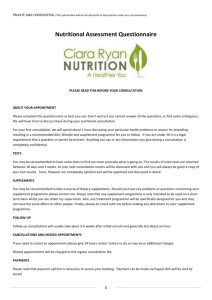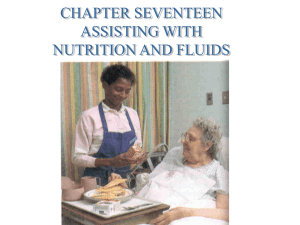WHY eat a balanced meal?
advertisement
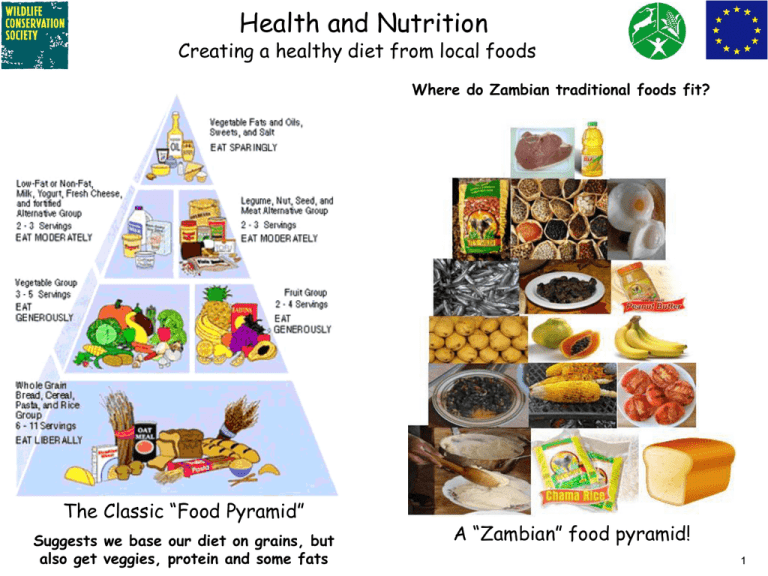
Health and Nutrition Creating a healthy diet from local foods Where do Zambian traditional foods fit? The Classic “Food Pyramid” Suggests we base our diet on grains, but also get veggies, protein and some fats A “Zambian” food pyramid! 1 Health and Nutrition Creating a healthy diet from local foods What MAKES a balanced meal? All 3 foods: starch, protein, vegetable!! • More than just starch! Nshima alone is NOT a balanced meal! • Daily sources of protein and vegetable – – • Beans, ground nuts, egg, milk Meat, chicken, kapenta, mopane worms WHY eat a balanced meal? • Kids need protein to grow healthy brains, internal organs and muscles – • – Pumpkin leaf, tomatoes, onions, squash, mangos, papaya, banana Kids need fruit and vegetables which have vitamins and minerals needed for: – Daily sources of fruit or vegetable – – • Fruit and vegetables that are dark colored are more nutritious than pale ones! Vegetable fats (like those in beans and corn) are more healthy than fats found in meats (like the fat on t-bone!) Good eyesight (Vit A – in pumpkin, squash and sweet potatoes, carrots) Healthy teeth (Vit C, in tomatoes) Strong bones (Calcium, in dark green leaves) Men AND Women need these too! – Healthy Tips! There’s 4 TIMES as much protein in beans as there is in nshima! Roasted ground nuts have 12 times the protein of nshima! – – Folic acid, found in dark green leafy vegetables, prevents spinal birth defects EXTRA calcium, protein and fats are needed to make healthy breast milk for growing babies Iodine, found in fish and iodine-treated salt, helps reduce mental retardation of babies and gives adults healthy thyroids glands – the gland that controls our energy levels! 2 Health and Nutrition Creating a healthy diet from local foods Group MEN WOMEN Nutritional Needs Two mixed meals every day and some snacks. They can get enough energy from a few large meals and from bulky foods. Heavy work like farming and cutting wood may increase needs. At least two mixed meals every day and some snacks. They can get enough energy from a few large meals and from bulky foods. Women doing heavy field work will need extra protein with extra starch. If they are pregnant or nursing, women need as much food as men - especially if they are also doing hard physical work like farming. Women need much more iron, calcium, protein and folate when they are pregnant or nursing. NURSING PREGNANT ELDERLY Group At least two and maybe more meals each day as they may not eat much at each meal. They need less starch than young people but about the same amount of protein and vegetables. Old people may need soft food because of mouth pain and lost teeth. Teens Nutritional Needs At least two large mixed meals and some snacks each day. Boys need a lot of energy. Girls need plenty of iron and calcium. Pregnant teen girls are still growing so they need more food than pregnant adult women. School-age children need at least two to three mixed meals WITH PROTEIN and some snacks each day. Fruit and vegetable is essential! School Kids Children one to five years old need breast milk until they are at least two years old. They need at least three mixed meals and two snacks each day. They cannot eat large bulky meals. They MUST have protein to prevent liver damage, and a mixed diet for Kids 1-5 yrs essential vitamins and minerals! Babies Babies six to 12 months old need breast milk at least 8-10 times per day. They need small meals, three to five times a day. Babies under six months of age need only breast milk at least ten times each day. 3 Health and Nutrition Creating a healthy diet from local foods Food habits that are BAD for you! HEALTHY TIPS! • • • • • • Boiling takes vitamins out of food and puts them into the water! If you boil veggies, use the water for soup or porridge, or drink it for a healthy boost after it cools! Rather than boiling food in lots of water, try putting on the lid, and steaming foods in just a little water. Roller meal is healthier than breakfast meal because it has more fiber and protein! Brown rice is healthier than white rice for the same reasons! Eat fruit and vegetables raw to get the full food value, but be sure that you’ve washed the dirt off with pure water. Ground nuts are best for you if roasted as soon as they are dry after harvest. Make healthy tea out of many herbs such as lemon grass, mint or wild basil! These are easy to grow and will last a long time. Honey is healthier than cane sugar! • • • • • • Too much salt causes heart disease and high blood pressure. If the food tastes salty – IT’S TOO MUCH!! Too much fat or oil not only makes you fat, it increases your risk of heart attack. Chose vegetable fats, like corn oil, & don’t eat the fat from meats like T-bone or chicken skin. Fried foods are high in fat and less healthy than foods which are roasted or boiled. Use the smallest amount of oil possible for good health!! You’re a better host if you serve healthy food! If you can see the oil on the plate, you’ve used TOO MUCH! Too much sugar is also bad, as it causes tooth decay and weight gain without healthy nutrients! Save it as a rare treat! Never eat meat raw – it can have bacteria and worm eggs! Do NOT give honey to babies under age 6 months – it can have tiny amounts of botulism toxin that won’t hurt the rest of us, but can hurt the baby! Eating a balanced diet of healthy foods is especially important for people living with HIV!! 4
